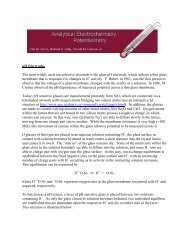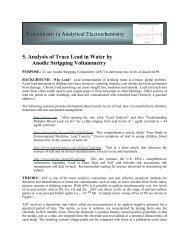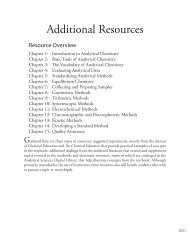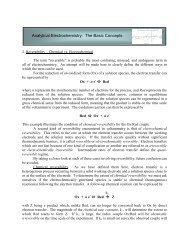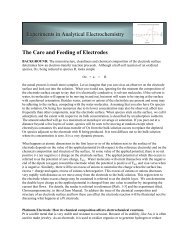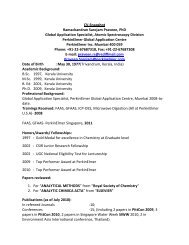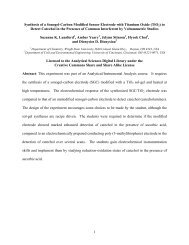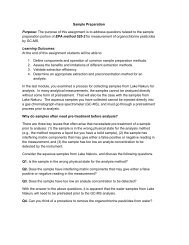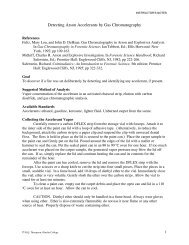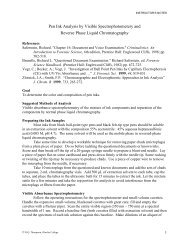Chapter 5 - Analytical Sciences Digital Library
Chapter 5 - Analytical Sciences Digital Library
Chapter 5 - Analytical Sciences Digital Library
Create successful ePaper yourself
Turn your PDF publications into a flip-book with our unique Google optimized e-Paper software.
174 <strong>Analytical</strong> Chemistry 2.0<br />
Fi n d i n g t h e Sl o p e a n d y-In t e r ce p t<br />
Although we will not formally develop the mathematical equations for a<br />
linear regression analysis, you can find the derivations in many standard<br />
statistical texts. 6 The resulting equation for the slope, b 1 , is<br />
b<br />
1<br />
∑<br />
n x y − x y<br />
i i<br />
i<br />
i<br />
i i<br />
=<br />
∑<br />
2<br />
n x − x<br />
and the equation for the y-intercept, b 0 , is<br />
i<br />
∑<br />
i<br />
∑ ∑<br />
∑<br />
i<br />
i<br />
2<br />
i<br />
5.17<br />
y −b x<br />
i 1 i<br />
i<br />
i<br />
b =<br />
5.18<br />
0<br />
n<br />
Although equation 5.17 and equation 5.18 appear formidable, it is only<br />
necessary to evaluate the following four summations<br />
∑<br />
i<br />
x i<br />
∑<br />
i<br />
y i<br />
∑<br />
i<br />
∑<br />
xy i i<br />
∑<br />
i<br />
2<br />
x i<br />
See Section 5F in this chapter for details<br />
on completing a linear regression analysis<br />
using Excel and R.<br />
Equations 5.17 and 5.18 are written in<br />
terms of the general variables x and y. As<br />
you work through this example, remember<br />
that x corresponds to C std , and that y<br />
corresponds to S std .<br />
Many calculators, spreadsheets, and other statistical software packages are<br />
capable of performing a linear regression analysis based on this model. To<br />
save time and to avoid tedious calculations, learn how to use one of these<br />
tools. For illustrative purposes the necessary calculations are shown in detail<br />
in the following example.<br />
Example 5.9<br />
Using the data from Table 5.1, determine the relationship between S std<br />
and C std using an unweighted linear regression.<br />
So l u t i o n<br />
We begin by setting up a table to help us organize the calculation.<br />
x i y i x i y i<br />
2<br />
x i<br />
0.000 0.00 0.000 0.000<br />
0.100 12.36 1.236 0.010<br />
0.200 24.83 4.966 0.040<br />
0.300 35.91 10.773 0.090<br />
0.400 48.79 19.516 0.160<br />
0.500 60.42 30.210 0.250<br />
Adding the values in each column gives<br />
2<br />
∑ x i<br />
= 1.500 ∑ y i<br />
= 182.31 ∑ xy i i<br />
= 66.701 ∑ x i<br />
= 0.550<br />
i<br />
i<br />
i<br />
i<br />
6 See, for example, Draper, N. R.; Smith, H. Applied Regression Analysis, 3rd ed.; Wiley: New<br />
York, 1998.



